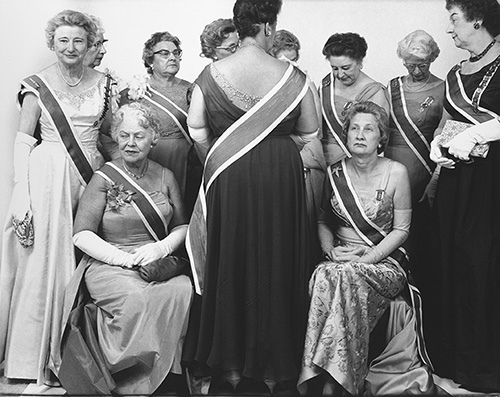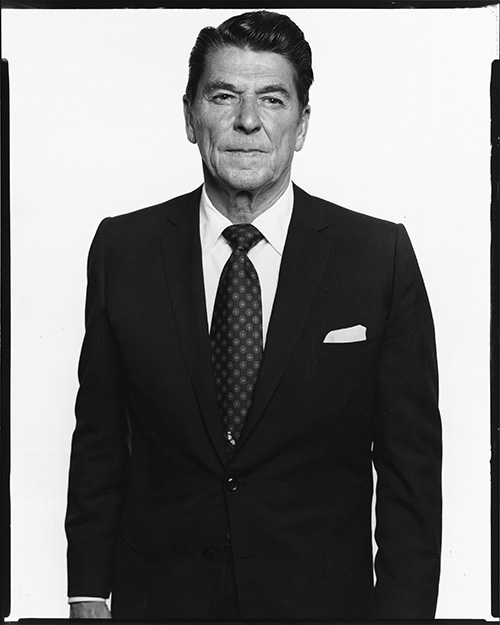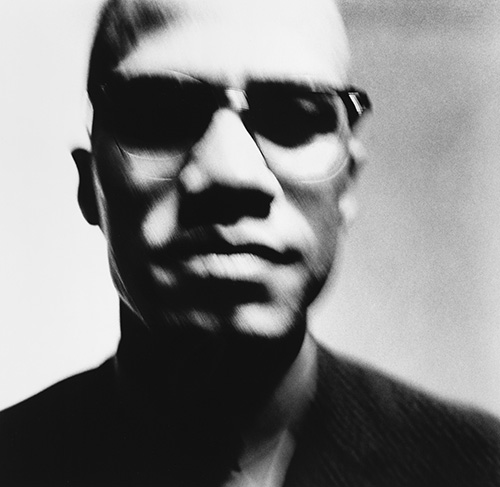
The Generals of the Daughters of the American Revolution, DAR Convention,
Mayflower Hotel, Washington, D.C., October 15, 1963,
© 2008 The Richard Avedon Foundation
There really isn’t a just way to describe how incredible and important Richard Avedon’s photographs are, at least in words that haven’t already been written or spoken. He’s been called “America’s pre-eminent editorial portrait and fashion photographer” which is accurate, but he, like all master photographers, is also a great historian. Richard Avedon: Portraits of Power, a new exhibit set to open this Saturday at the Corcoran Gallery of Art, has brought together more than 200 of his photos that cover over 50 years of his career and of American history, some of them having never been on exhibit or published.
One of the first things to know about Avedon is that his work and life were one and the same. He once said, “I believe in maniacs. I believe in type As. I believe that you’ve got to love your work so much that it is all you want to do. I believe you must betray your mistress for your work, you betray your wife for your work; I believe that she must betray you for her work. I believe that work is the one thing in the world that never betrays you, that lasts. If I were going to be a politician, if I were going to be a scientist, I would do it every day. I wouldn’t wait for Monday. I don’t believe in weekends.”
Avedon would do extensive research on many his subjects before working with them. If they were a writer, he’d read their books. If they were an artist, he’d view their work to grasp who they really were. In doing so, he was able to come up with a way to capture the essence of his sitters rather than just stage them, light them, and shoot them. As he said in 1994, “I’ve worked out of a series of no’s. No to exquisite light, no to apparent compositions, no to the seduction of poses or narrative. And all these no’s force me to the ‘yes.’ I have a white background. I have the person I’m interested in and the thing that happens between us.”
That “white background” that he mentions marked a shift in his style and is what most people think of when they envision one of Avedon’s photographs. This change took place in 1969 when he started shooting with an 8×10 view camera and an even lighting source. By shooting his subjects in front of a plain white background, he omitted time and place from his photographs, focusing on the detail of his subjects.

Ronald Reagan, former Governor of California, March 4, 1976,
© 2008 The Richard Avedon Foundation
However during these shoots, regardless of what he had intended to happen, there were sometimes spontaneous surprises that he ultimately went with. I couldn’t help but think that some of the photographs on display were candid or accidental, such as the photo below of Malcolm X. Perhaps he was in the process of setting the right shutter speed when he took this shot, but when it came out of the dark room he may have said, “This is who Malcolm X is. Let’s go with it.”

Malcolm X, black nationalist leader, New York, March 27, 1963,
© 2008 The Richard Avedon Foundation
Due to his achieved fame and employment for such magazines as Harper’s Bazaar, Vogue, and The New Yorker, Richard Avedon had unprecedented access to powerful or politically active, creative people. When you walk out of the exhibit it’s hard to believe just who he was able to work with over the course of his career. Just to name of few, Charlie Chaplin, John F. Kennedy, Ronald Reagan, Jimmy Carter, Dwight Eisenhower, Malcolm X, Aldous Huxley, Joe Louis, Arthur Miller, Buckminster Fuller, Katherine Graham, Ralph Nader, Edward Kennedy, The Joint Chiefs of Staff (1976), Andy Warhol, Marilyn Monroe, Salman Rushdie, the Dalai Lama, and Kofi Annan.
Sometimes he experienced unexpected behavior from these “people of power”. For example, as Avedon led Henry Kissinger to the camera he said, “Be kind to me.” Avedon wondered if that meant that Kissinger wanted to look taller, more friendly, or less Jewish. On another occasion, Jamie Raskin, who was a professor of constitutional law at AU at the time, looked at his finished portrait and thought that it looked nothing like him. However the more he looked at it, the more he learned about himself and who he was capable of being, and ultimately chose to run for and become an elected state senator. That’s an example of the kind of power Avedon’s portraits have.
Today Avedon’s legacy is cared for by none other than The Richard Avedon Foundation, otherwise known as “The Avedon Police”. He died in 2004 from a brain hemorrhage while doing a photography series for The New Yorker titled Democracy (which is on display as part of this exhibit), and expressed in his will that when he was gone there were to be no more prints made of his photographs, making them all the more valuable. The Foundation sees to it that his wishes are upheld as well as tackling the daunting task of digitizing over 500,000 negatives that Avedon left behind. The staff “encourages the study and appreciation of Avedon’s photography through publications, touring exhibits, and outreach to the academic community.”
Even if you’re not overly interested in photography (maybe painting is your thing?), I highly recommend going to see this exhibit. When you view each image, ask yourself, “Who has the power in this photo?” Is it the subject, the scene, Avedon, or you the viewer? Notice the shallow depth of field in some photos that gives added focus and emphasis to the subject. Notice how this exhibit shows the highs and lows of our political process and think about that in the context of our current presidential election. Get up close to the photos and look at the light in the subject’s eyes. Sometimes you can see the studio, the type of lighting that was used, and even a faint reflection of Avedon himself.
Art lover or not, these photos will speak to you. What better place than Washington to host an exhibit about politics and power?
Richard Avedon: Portraits of Power
Corcoran Gallery of Art
September 13, 2008–January 25, 2009
This is a great piece, Max, very thoughtful. I was debating going to this exhibit and you’ve really convinced me. Thanks!
Thanks, Jenn, you won’t be disappointed. If you liked the Annie Leibovitz exhibit they had, you’ll definitely enjoy this show too.
BTW, tickets are $14 for adults unless you’re a Corcoran member.
Well written Max. I have been anxious to see this, and it was nice to get a preview through your thoughts.
Thanks, Meaghan. It’ll be easy to spend over an hour in there…it’s a bit overwhelming. The space is basically the size of the Leibovitz and Adams exhibit combined!
Very well written Max. It seems as though you have studied Mr. Avedon as well as he studied some of the people that he was fortunate enough to have photographed. His legacy will continue.
Pingback: Edward Burtynsky: Oil » We Love DC